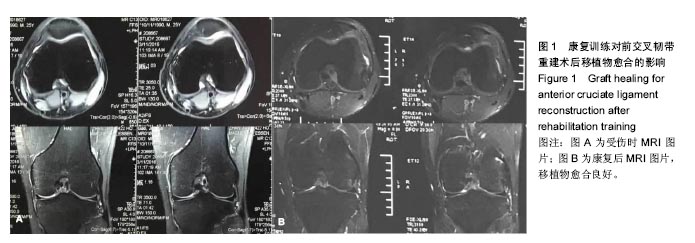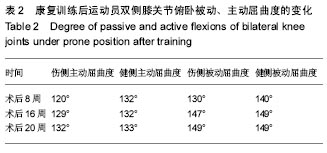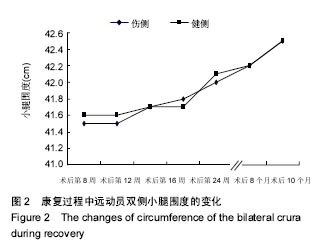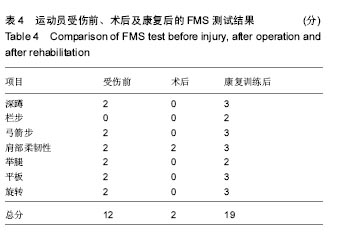中国组织工程研究 ›› 2018, Vol. 22 ›› Issue (2): 281-287.doi: 10.3969/j.issn.2095-4344.0019
• 材料生物相容性 material biocompatibility • 上一篇 下一篇
前交叉韧带重建后移植物愈合和功能恢复:康复训练个案观察
傅 涛,吴 鹏,赵林梁,程 吉
- 天津体育学院,天津市 300381
Graft healing and functional recovery after anterior cruciate ligament reconstruction: a case study of rehabilitation training
Fu Tao, Wu Peng, Zhao Lin-liang, Cheng Ji
- Tianjin University of Sport, Tianjin 300381, China
摘要:
文章快速阅读:
.jpg)
文题释义:
前交叉韧带重建:前交叉韧带位于膝关节内,连接股骨与胫骨,主要作用是限制胫骨向前过度移位,它与膝关节内其他结构共同作用,来维持膝关节的稳定性。前交叉韧带断裂后膝关节明显不稳,严重影响膝关节功能。手术目前多采用四股半腱肌/股薄肌肌腱,它的刚度是正常前交叉韧带的4倍,其目的是重建稳定的膝关节以获得更好的运动表现,同时保护膝关节的其他结构免受损伤。
前交叉韧带重建后的康复训练:前交叉韧带重建手术后需要固定至少2周左右,为防止因长期制动所导致的膝关节功能障碍,需要早期介入康复训练,康复训练能够消炎、消肿,促进组织修复,减少瘢痕,防止粘连,最大限度地恢复膝关节功能,改善患者的生存质量,促进运动员早日重返赛场。
背景:前交叉韧带的损伤将直接影响到个体的下肢功能,对运动员而言更为严重,前交叉韧带重建术后的康复训练是否合理、有效,是否可以恢复膝关节的正常功能甚为重要。
目的:探究康复训练对前交叉韧带重建术后移植物愈合及膝关节功能恢复的影响。
方法:以1名国家男子橄榄球队优秀运动员为个案研究,对其前交叉韧带重建术后进行分阶段系统的康复训练,康复前后拍摄MRI,分别进行关节屈曲度、腿部围度、下肢等速力量、YBT测试、BESS测试、前馈测试、单脚静态平衡测试、双脚动态平衡测试、Lysholm膝关节评分、上肢无氧功、躯干力量等检测,分析康复训练对运动员前交叉韧带重建术后移植物愈合情况、身体形态、膝关节功能和身体素质的积极影响。
结果与结论:通过术后10个月的分阶段康复训练,运动员前交叉韧带重建术后移植物愈合良好,膝关节屈曲度恢复正常,膝关节水肿基本消除,膝关节伸屈肌力量恢复到受伤前的95%以上,膝关节功能测试良好,关节功能也恢复了较高水平,Lysholm膝关节评分85分,上肢无氧功和躯干力量达到受伤前的120%,身体各项素质较受伤前有了较大提高。此次的康复训练对运动员前交叉韧带损伤重建术后移植物愈合、膝关节功能、肌肉力量和身体素质恢复有较好的促进作用。
中图分类号:








.jpg)
.jpg)